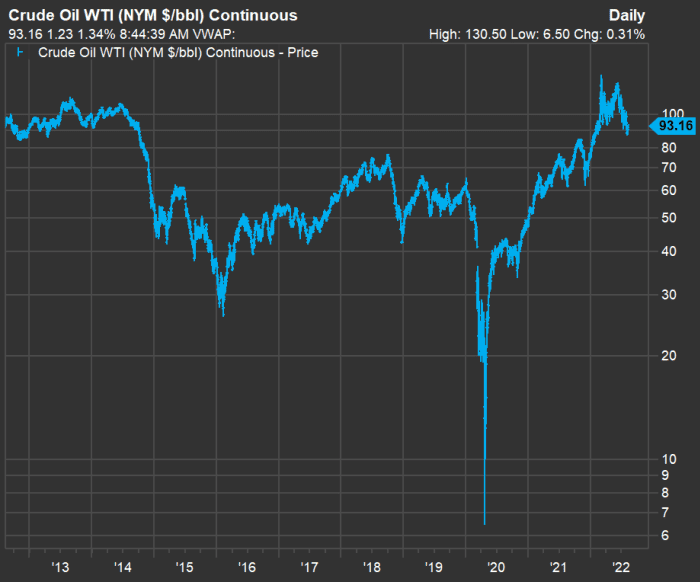Oil prices are down, but energy companies’ earnings estimates keep rising — these stocks are cheap
Oil prices have fallen from a peak earlier this year. But energy companies’ earnings estimates have kept rising on stronger demand and low capital spending.
Below is a screen of large-cap oil stocks as a starting point for investors.
Take a look at a 10-year chart of continuous front-month quotes for West Texas Intermediate (WTI) crude oil CL.1,

Leaving aside the distortion in the energy market during the early part of the coronavirus pandemic in 2020, some investors have had little faith in oil and natural-gas-related stocks since the broad price decline from mid-2014 through early February 2016.
But the supply-and-demand balance has been changing, as oil companies have lowered their capital expenditures in recent years, even as demand has been increasing.
WTI was trading for $93.11 a barrel on Aug. 11, down 29% from its intraday peak at $130.50 on March 7. But it was still up 24% from then end of 2021, when it traded at $75.21. That was before Russia roiled the world energy market by invading Ukraine.
As always, there are many moving parts for energy. The Organization of the Petroleum Exporting Countries has lowered its forecast for oil demand in 2022. Then again, analysts at BCA Research led by the firm’s chief commodity and energy strategist, Robert Ryan, predicted that Brent crude oil BRN00,
Prime example: Exxon Mobil
Even though oil had already pulled back considerably at the start of the second quarter, industry profits were way up in the three months through June. For example, Exxon Mobil Corp.’s XOM,
One important factor for investors is that rolling 12-month earnings-per-share estimates — upon which forward price-to-earnings ratios are based — keep increasing.
Exxon Mobil’s forward P/E is 8, compared with 8.2 for the S&P 500 energy sector and 18 for the full S&P 500 SPX,
A screen of large-cap energy stocks
The S&P 500 energy sector is made up of 21 companies and is tracked by the Energy Select Sector SPDR Fund XLE,
For a broader approach, the iShares Global Energy ETF IXC,
Both ETFs provide broad exposure to the oil and natural gas industries. But some investors may wish to dig further into individual names. So the following screen began with IXC’s 47 stocks.
Many people look to the energy sector for dividends. But a very high dividend yield is a warning that investors — especially well-informed institutional investors — expect the payout to be cut. So we began this screen by removing the four stocks with dividend yields above 10%.
Then we looked further into dividend coverage. One way to estimate dividend-paying ability is to look at free cash flow estimates. We can divide estimated free cash flow per share by the current share price for an estimated FCF yield. If this is higher than the current dividend yield, a company appears to have “headroom” to raise its dividend, buy back shares or take other actions that may benefit investors.
Among the remaining 43 stocks held by IXC, consensus forward FCF estimates are available from FactSet for 42, and 40 have estimated FCF headroom of at least 1%.
Here are the 10 remaining companies with single-digit P/E ratios that have had their consensus 12-month EPS estimates increase the most over the past month. All have high levels of indicated FCF headroom:
| Company | Ticker | Forward P/E | Increase in rolling 12-month EPS estimate from a month ago | Dividend yield | Estimated FCF yield | Estimated FCF headroom |
| Marathon Petroleum Corp. | MPC, |
6.4 | 28.8% | 2.44% | 17.03% | 14.59% |
| Valero Energy Corp. | VLO, |
6.0 | 17.0% | 3.51% | 17.61% | 14.10% |
| Phillips 66 | PSX, |
6.6 | 12.3% | 4.53% | 17.16% | 12.63% |
| Eni S.p.A. | ENI, |
3.8 | 9.8% | 7.70% | 24.73% | 17.03% |
| Cenovus Energy Inc. | CVE, |
4.4 | 8.6% | 1.90% | 18.58% | 16.68% |
| Exxon Mobil Corp. | XOM, |
8.0 | 6.5% | 3.85% | 11.03% | 7.18% |
| Canadian Natural Resources Ltd. | CNQ, |
6.0 | 5.6% | 4.36% | 20.83% | 16.47% |
| Imperial Oil Ltd. | IMO, |
5.2 | 4.0% | 2.43% | 21.59% | 19.16% |
| Suncor Energy Inc. | SU, |
4.3 | 3.5% | 4.77% | 21.08% | 16.31% |
| Devon Energy Corp. | DVN, |
6.3 | 3.5% | 7.76% | 16.18% | 8.42% |
| Source: FactSet | ||||||
You should do your own research to form your own opinion about any individual stock you consider buying. One way to begin is by clicking on the tickers in the table for more information. Then read Tomi Kilgore’s detailed guide to the wealth of information for free on the MarketWatch quote page.



